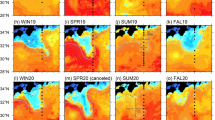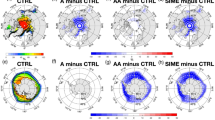Abstract
Previous research work found that two distinct surface air temperature (SAT) modes—the northern (N-) and the southern (S-) modes dominate the East Asian winter monsoon (EAWM) region. The inter-annual variations of these two modes were mainly attributed to preceding Siberian snow cover anomalies and El Niño–Southern Oscillation (ENSO). Observed evidence in this study shows that sea ice anomalies on Barents–Kara (BK) and Laptev Seas and those on Chukchi–Beaufort (CB) Sea in autumn have co-mingled effects on the two abnormal EAWM modes. If negative sea ice anomalies appear in the BK and northern CB Sea in September–October (SO), the following winter SAT anomaly over East Asia is featured by an obvious cooling north of 40° N, which highly resembles the SAT N-mode of EAWM. If negative sea ice anomalies occur in BK–Laptev Sea but positive anomalies in the southern CB Sea, the East Asia winter SAT anomaly exhibits a salient cold condition over the south of 40° N and corresponds to the EAWM S-mode. The above results indicate that autumn Arctic sea ice can provide another predictability source for the EAWM, besides Siberian snow cover and ENSO. To further verify its contribution to seasonal prediction of the EAWM, a series of physical–empirical models are established using the combinations of SO Arctic sea ice, autumn Siberian snow cover and ENSO. Hindcast experiment output shows when adding autumn Arctic sea ice into the predictors, the cross-validated prediction skill is significantly improved. The possible physical mechanisms on how preceding Arctic sea ice anomalies impact on the N- and S- modes are also discussed.










Similar content being viewed by others
References
Blockeel H, Struyf J (2002) Efficient algorithms for decision tree cross-validation. J Mach Learn Res 3:621–650
Budikova D (2009) Role of Arctic sea ice in global atmospheric circulation: a review. Glob Planet Change 68:149–163
Capotondi A et al (2015) Understanding ENSO diversity. Bull Am Meteorol Soc 96:921–938
Chen W, Graf HF, Huang RH (2000) The interannual variability of East Asian winter monsoon and its relation to the summer monsoon. Adv Atmos Sci 17:46–60
Chen Z, Wu R, Chen W (2014) Impacts of autumn Arctic sea ice concentration changes on the East Asian winter monsoon variability. J Clim 27:5433–5450
Chevallier M, Salas-Melia D (2012) The role of sea ice thickness distribution in the Arctic sea ice potential predictability: a diagnostic approach with a coupled GCM. J Clim 25:3025–3038
Clark MP, Serreze MC (2000) Effects of variations in East Asian snow cover on modulating atmospheric circulation over the North Pacific Ocean. J Clim 13:3700–3710
Cohen J, Screen JA, Furtado JC et al (2014) Recent Arctic amplification and extreme mid-latitude weather. Nat Geos 7:627
Comiso JC (2012) Large decadal decline of the Arctic multiyear ice cover. J Clim 25:1176–1193
Dee DP et al (2011) The ERA-Interim reanalysis: configuration and performance of the data assimilation system. Q J R Meteorol Soc 137:553–597
Ding YH (1994) Monsoon over China. Kluwer Academic, Dordrecht, p 420
Estilow TW, Young AH, Robinson DA (2015) A long-term Northern Hemisphere snow cover extent data record for climate studies and monitoring. Earth Syst Sci Data 7:137–142
Francis JA, Vavrus SJ (2012) Evidence linking Arctic amplification to extreme weather in mid-latitudes. Geophys Res Lett 39:L06801
Francis JA, Chan W, Leathers DJ, Miller JR, Veron DE (2009) Winter Northern hemisphere weather patterns remember summer Arctic sea-ice extent. Geophys Res Lett 36:L07503
Gong G, Entekhabi D, Cohen J (2003) Modeled Northern Hemisphere winter climate response to realistic Siberian snow anomalies. J Clim 16:3917–3931
He SP, Wang HJ (2013) Oscillating relationship between the East Asian Winter monsoon and ENSO. J Clim 26:9819–9838
Holton JR (2004) An introduction to dynamic meteorology, 4th edn. Elsevier Academic Press, Oxford
Honda M, Inoue J, Yamane S (2009) Influence of low Arctic sea-ice minima on anomalously cold Eurasian winters. Geophys Res Lett 36:L08707
Hopsch S, Cohen J, Dethloff K (2012) Analysis of a link between fall Arctic sea ice concentration and atmospheric patterns in the following winter. Tellus A 64:18624
Inoue J, Hori ME, Takaya K (2012) The role of Barents Sea ice in the wintertime cyclone track and emergence of a warm-Arctic cold–Siberian anomaly. J Clim 25:2561–2568
Jhun J-G, Lee E-J (2004) A new East Asian Winter Monsoon Index and associated characteristics of the Winter Monsoon. J Clim 17:711–726
Jia X, Lin H, Ge J (2016) The interdecadal change of ENSO impact on wintertime East Asian climate. J Geophys Res 120:11918–11935
Koenigk T, Caian M, Nikulin G, Schimanke S (2016) Regional Arctic sea ice variations as predictor for winter climate conditions. Clim Dyn 46:317–337
Kug JS, Jeong JH, Jang YS, Kim BM, Folland CK, Min SK, Son SW (2015) Two distinct influences of Arctic warming on cold winters over North America and East Asia. Nat Geol 8:759
Lau KM, Li MT (1984) The monsoon of East Asia and its global associations—a survey. Bull Am Meteorol Soc 65:114–125
Lee JY, Lee SS, Wang B, Ha KJ, Jhun JG (2013) Seasonal prediction and predictability of the Asian winter temperature variability. Clim Dyn 41:573–587
Li F, Wang H (2014) Autumn Eurasian snow depth, autumn Arctic sea ice cover and East Asian winter monsoon. Int J Climatol 34:3616–3625
Liu G, Ji LR, Sun SQ, Xin YF (2012) Low- and midhigh latitude components of the East Asian winter monsoon and their reflecting variations in winter climate over eastern China. Atmos Ocean Sci Lett 5:195–200
Lu MM, Chang C-P (2009) Unusual late-season cold surges during the 2005 Asian winter monsoon: roles of Atlantic blocking and the central Asian anticyclone. J Clim 22:5205–5217
Luo X, Wang B (2018) How autumn Eurasian snow anomalies affect East Asian winter monsoon: a numerical study. Clim Dyn 52:69–82
Mori M, Watanabe M, Shiogama H, Inoue J, Kimoto M (2014) Robust Arctic sea-ice influence on the frequent Eurasian cold winters in past decades. Nat Geosci 7:869–873
North GR, Bell TL, Cahalan RF, Moeng FJ (1982) Sampling errors in the estimation of empirical orthogonal functions. Mon Weather Rev 110:699–706
Overland JE, Wang M (2010) Large-scale atmospheric circulation changes are associated with the recent loss of Arctic sea ice. Tellus A 62:1–9
Palmén E, Newton CW (1969) Atmospheric circulation systems, international geophysics series, vol 13. Academic, New York
Petoukhov V, Semenov VA (2010) A link between reduced Barents–Kara sea ice and cold winter extremes over northern continents. J Geophys Res 115:D21111
Rayner NA, Parkler DE, Horton EB, Folland CK, Alexander LV, Rowell DP, Kent EC, Kaplan A (2003) Global analyses of sea surface temperature, sea ice, and night marine air temperatures since the late nineteenth century. J Geophys Res 108(D14):4407
Robinson DA, Frei A (2000) Seasonal variability of northern hemisphere snow extent using visible satellite data. Prof Geogr 51:307–331
Robinson DA, Dewey KF, Heim R Jr (1993) Global snow cover monitoring: an update. Bull Am Meteorol Soc 74:1689–1696
Screen JA (2014) Arctic amplification decreases temperature variance in northern mid-to high-latitudes. Nat Clim Change 4:577
Screen JA, Simmonds I (2013) Exploring links between Arctic amplification and mid-latitude weather. Geophys Res Lett 40:959–964
Solomon S, Qin D, Manning M, Marquis M, Averyt K, Tignor MMB, Miller HL, Chen Z (2007) Climate change 2007—the physical science basis: working group I contribution to the fourth assessment report of the IPCC, vol 4. Cambridge University Press, Cambridge
Stroeve JC, Maslanik J, Serreze MC, Rigor R, Meier W, Fowler C (2011) Sea ice response to an extreme negative phase of the Arctic Oscillation during winter 2009/2010. Geophys Res Lett 38:L02502
Sun C, Yang S, Li W, Zhang R, Wu R (2016) Interannual variations of the dominant modes of East Asian winter monsoon and possible links to Arctic sea ice. Clim Dyn 47:481–496
Tang Q, Zhang X, Yang X, Francis JA (2013) Cold winter extremes in northern continents linked to Arctic sea ice loss. Environ Res Lett 8:014036
Tao SY, China Meteorological administration (1957) A study of activities of cold airs in East Asian winter. Handbook of short-term forecast. Meteorology Press, Beijing, pp 60–92 (in Chinese)
Vihma T (2014) Effects of Arctic sea ice decline on weather and climate: a review. Surv Geophys 35:1175–1214
Wang L, Chen W (2010) How well do existing indices measure the strength of the East Asian winter monsoon? Adv Atmos Sci 27:855–870
Wang L, Chen W (2014) An intensity index for the East Asian winter monsoon. J Clim 27:2361–2374
Wang B, Wu R, Fu X (2000) Pacific-East Asia teleconnection: how does ENSO affect East Asian climate? J Clim 13:1517–1536
Wang L, Chen W, Huang RH (2008) Interdecadal modulation of PDO on the impact of ENSO on the East Asian winter monsoon. Geophys Res Lett 35:L20702
Wang B, Lee JY, Kang IS, Shukla J, Park CK, Kumar A et al (2009) Advance and prospectus of seasonal prediction: assessment of the APCC/CliPAS 14-model ensemble retrospective seasonal prediction (1980–2004). Clim Dyn 33:93–117
Wang B, Wu Z, Chang CP, Liu J, Li J, Zhou T (2010) Another look at interannual-to-interdecadal variations of the East Asian winter monsoon: the northern and southern temperature modes. J Clim 23:1495–1512
Wu B, Huang RH, Gao DY (1999) Impact of variations of winter sea-ice extents in the Kara/Barents Seas on winter monsoon over East Asia. Acta Meteorol Sin 13:141–153 (in Chinese)
Wu Z, Li J, Wang B, Liu X (2009) Can the Southern Hemisphere annular mode affect China winter monsoon? J Geophys Res 114:D11
Wu Z, Li J, Jiang Z, He J (2011) Predictable climate dynamics of abnormal East Asian winter monsoon: once-in-a-century snowstorms in 2007/2008 winter. Clim Dyn 37:1661–1669
Wu Z, Li X, Li Y (2016) Potential influence of Arctic sea ice to the inter-annual variations of East Asian spring precipitation. J Clim 29:2797–2813
Wu B, Su J, D’Arrigo R (2015) Patterns of Asian winter climate variability and links to Arctic sea ice. J Clim 28:6841–6858
Yu L, Wu Z, Zhang R, Yang X (2018) Partial least regression approach to forecast the East Asian winter monsoon using Eurasian snow cover and sea surface temperature. Clim Dyn 51:4573–4584
Zhang X, Walsh JE (2006) Toward a seasonally ice-covered Arctic Ocean: scenarios from the IPCC AR4 model simulations. J Clim 19:1730–1747
Zhang R, Sumi A, Kimoto M (1996) Impact of El Niño on the East Asian monsoon: a diagnostic study of the ’86/87 and ’91/92 events. J Meteorol Soc Jpn 74:49–62
Zhang X, Sorteberg A, Zhang J, Gerdes R, Comiso JC (2008) Recent radical shifts of atmospheric circulations and rapid changes in Arctic climate system. Geophys Res Lett 35:L22701
Zhang P, Wu ZW, Chen H (2017) Interdecadal variability of the ENSO–North Pacific atmospheric circulation in winter. Atmos Ocean 55(2):110–120
Zhang J, Stegall ST, Zhang X (2018) Wind–sea surface temperature–sea ice relationship in the Chukchi–Beaufort Seas during autumn. Environ Res Lett 13:034008
Zhang P, Wu ZW, Li JP (2019a) Reexamining the relationship of La Niña and the East Asian Winter Monsoon. Clim Dyn 53:779–791
Zhang P, Wang B, Wu ZW (2019b) Weak El Niño and Winter climate in the mid-to high latitudes of Eurasia. J Clim 32:405–421
Zuo J, Ren HL, Wu B, Li W (2016) Predictability of winter temperature in China from previous autumn Arctic sea ice. Clim Dyn 47:2331–2343
Acknowledgements
We thank the two anonymous reviewers for their comments and suggestions. This research was jointly supported by the National Natural Science Foundation of China (Grant Nos. 41790475, 41905056 and 91937302) and the Ministry of Science and Technology of China (Grant No. 2016YFA0601801).
Author information
Authors and Affiliations
Corresponding author
Additional information
Publisher's Note
Springer Nature remains neutral with regard to jurisdictional claims in published maps and institutional affiliations.
Rights and permissions
About this article
Cite this article
Zhang, P., Wu, Z., Li, J. et al. Seasonal prediction of the northern and southern temperature modes of the East Asian winter monsoon: the importance of the Arctic sea ice. Clim Dyn 54, 3583–3597 (2020). https://doi.org/10.1007/s00382-020-05182-w
Received:
Accepted:
Published:
Issue Date:
DOI: https://doi.org/10.1007/s00382-020-05182-w




